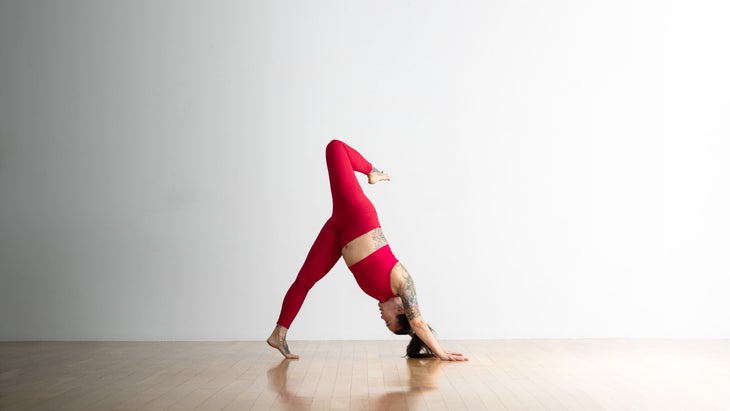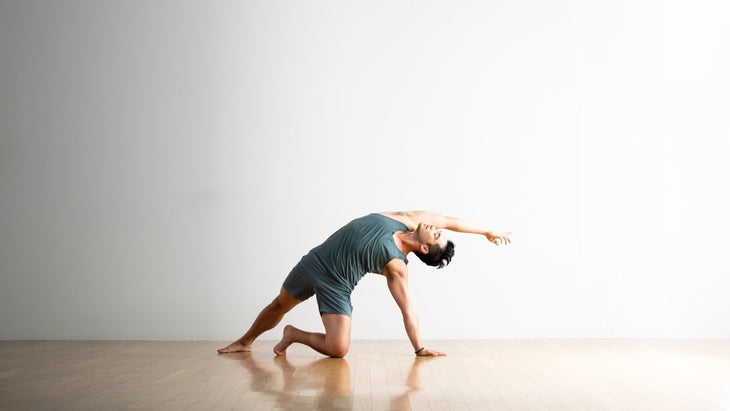Heading out the door? Read this article on the new Outside+ app available now on iOS devices for members! Download the app.
Wild Thing creates a powerful connection to your mind, body and breath in a joyful way. Energetically, opening your chest, throat and third eye in this backbend can give you a sense of freedom. When you inhale and reach your top arm up and over your ear, you may feel wild, like anything you can dream up is within your reach. Physically, you must tap into your strength in order to balance on one hand and the pinky edge of your foot. You also need flexibility to flip your leg around from One-Legged Downward-Facing Dog to behind you and onto the floor.
The pose works so much of the body—hands, wrist, arms, back, hips, quads and feet—and that makes it satisfying. It can be a grounding posture, or it can make you feel like you are flying. Notice how this pose shows up differently on different days. But each time, no matter what mood you’re in, the pose exudes positivity and creates a lot of confidence in the amazing things human beings can do.
Wild Thing Basics
Sanskrit Name: Camatkarasana (KUH-mutt-Kuh-RUSS-uh-nuh)
Pose Type: Arm balance
Targets: Upper Body, Back
Why We Love It: No wonder this pose is suggested to relieve fatigue or mild depression. Wild Thing seems 100 percent designed to delight. It’s complex and takes a bit of coordination to get into, but along the way we practice being fearless and flexible. And once you’re in it, it’s all play.
Pose Benefits
Wild thing opens up chest, lung, and shoulder areas, as well as the front of the legs and hip flexors. It builds strength in shoulders and upper back. Avoid this pose if you have carpal tunnel syndrome or rotator cuff injuries.
Wild Thing: Step-by-Step Instructions
- Start in Adho Mukha Svanasana (Downward-Facing Dog).
- Bring your weight into your right hand and roll onto the outer edge of your right foot like Vasisthasana (Side Plank Pose).
- On an inhalation, lift your hips with buoyancy. Stay strong in your right hand making a clawing action with the fingers. Keep the head of the right arm bone back. On an exhalations, step your left foot back and place your toes on the floor with your knee partially bent.
- Curl back through your upper back to create a sweeping action of the shoulder blades into the back of the rib cage.
- On an inhalation lift your hips higher until you curl more into a backbend with your right foot solid on the ground.
- Keep breathing and curl your head back, extending your left arm from your heart and expressing your power and freedom.
- Hold for 5-10 breaths breaths, return to Down Dog and repeat on the other side.
Variations
Wild Thing preparation

Work your way into Wild Thing by practicing Three-legged Downward-Facing Dog. Come into Down Dog, lift your right leg high, bend your knee, and direct your foot toward your left hip.
Wild Thing

For more support, practice with one knee down. From Tabletop, lift your right arm out to the side and open your torso to the right. Straighten your right leg, extend it behind you, and direct it to the left side of your mat. You can bring your right hand around and overhead to open your chest to the ceiling.
Beginner’s Tip
If you’re afraid to go into Wild Thing, try Downward-Facing Dog with the right leg lifted, hip opened and knee bent. Open your right heel a little more to the ground with each inhale, stopping when you feel uncomfortable. Over time, as the foot gets closer to the ground, rotate the bottom hand outwardly. Go slowly and see if you can get the right foot to the floor—no rush, no hurry.
Teaching Camatkarasana
- Teach the pose from Downward-Facing Dog. As you press through both hands, lift the right leg, bend the knee and open the hip. Let the left hand firmly turn outward as the right leg lands behind the left leg on the floor (probably off the mat). Use the pinky edge of the left foot to prop you up. Lift the right arm up and over the ear.
- To feel this pose more fully, reach through the top right arm. Take the right hand to the heart and press the heart into the hand. Then re-lengthen the right arm with the chest more open and the heart puffed out,
- Once in the full expression, cue students to open the heart, throat and third eye by reaching through the top arm, lengthening through the back muscles, letting the head tilt back and lifting the heel of the right foot.
- If a student is well-balanced in the pose and wants to try more, cue them to lift the flipped right heel off the ground, coming to the ball of the right foot. The top right hand may reach for the right foot or calf as the left shoulder connects down the back to go deeper into the backbend. The right foot lifts off the mat, the right hand holds the calf or ankle.
Preparatory Poses
Adho Mukha Svanasana (Downward-Facing Dog)
Dhanurasana (Bow Pose)
Vasisthasana (Side Plank Pose)
Counter Poses
Adho Mukha Svanasana (Downward-Facing Dog)
Balasana (Child’s Pose)